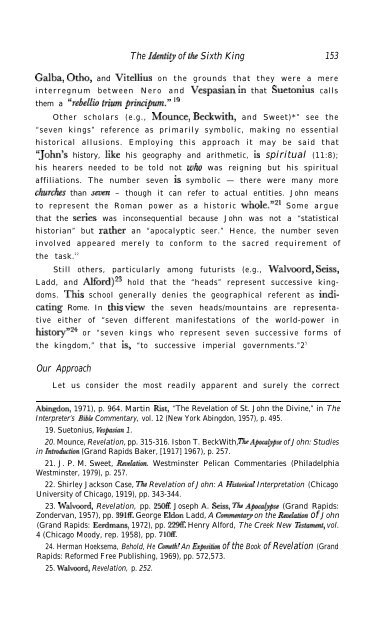- Page 2 and 3:
BEFORE JERUSALEM FELL
- Page 4 and 5:
BEFORE JERUSALEM FELL Dating the Bo
- Page 6 and 7:
Dedicated to Dr. Greg L. Bahnsen wh
- Page 8 and 9:
TABLE OF CONTENTS Publisher’s Pre
- Page 10 and 11:
PUBLISHER’S PREFACE by Gary North
- Page 12 and 13:
Publish/s Preface xi of Revelation.
- Page 14 and 15:
Publisher’s Preface . . . X111 Po
- Page 16 and 17:
Publisher’s Preface xv Th Beret o
- Page 18 and 19:
. . . Xvlll BEFORE JERUSALEM FELL I
- Page 20 and 21:
PART 1 PRELIMINARY CONSIDERATIONS
- Page 22 and 23:
4 BEFORE JERUSALEM FELL Thus, both
- Page 24 and 25:
6 BEFORE JERUSALEM FELL Regarding t
- Page 26 and 27:
8 BEFORE JERUSALEM FELL noted a qua
- Page 28 and 29:
10 BEFORE JERUSALEM FELL in 1910 th
- Page 30 and 31:
12 BEFORE JERUSALEM FELL all, as Re
- Page 32 and 33:
14 BEFORE JERUSALEM FELL Milo Conni
- Page 34 and 35:
I 16 BEFORE JERUSALEM FELL In the s
- Page 36 and 37:
18 BEFORE JERUSALEM FELL the two ge
- Page 38 and 39:
20 BEFORE JERUSALEM FELL Regarding
- Page 40 and 41:
22 BEFORE JERUSALEM FELL conviction
- Page 42 and 43:
24 BEFORE JERUSALEM FELL to exclude
- Page 44 and 45:
26 BEFORE JERUSALEM FELL The proble
- Page 46 and 47:
28 BEFORE JERUSALEM FELL was in tur
- Page 48 and 49:
30 Source Documentation We will cit
- Page 50 and 51:
32 BEFORE JERUSALEM FELL Heinrich B
- Page 52 and 53:
34 BEFORE JERUSALEM FELL Hermann Ge
- Page 54 and 55:
36 BEFORE JERUSALEM FELL James M. M
- Page 56 and 57:
38 BEFORE JERUSALEM FELL Moses Stua
- Page 58 and 59:
3 INTRODUCTION TO THE EXTERNAL EVID
- Page 60 and 61:
Introduction to the External Eviden
- Page 62 and 63:
4 IRENAEUS, BISHOP OF LYONS As we b
- Page 64 and 65:
Irenaas, Btihop of Lyons 47 nounced
- Page 66 and 67:
Irenaeus, Bishop of Lyn.s 49 (i.e.,
- Page 68 and 69:
Irenaeus, Bishop of Lyons 51 have b
- Page 70 and 71:
along the lines of Chase’s: Irena
- Page 72 and 73:
Irenaeu.s, Bishop ofLpns 55 accept
- Page 74 and 75:
Irenaeu-s, Bishop of Lyons 57 tian
- Page 76 and 77:
Irenaeus, Bishop of Lpn.s 59 rule.
- Page 78 and 79:
Irenaew, Bishop of Lyon.s 61 narrat
- Page 80 and 81:
Irenaeus, Bishop of Lpns 63 accept
- Page 82 and 83:
Irenaeus, Bishop of Lyons 65 upon t
- Page 84 and 85:
Ireruzeus, Bishop of Lpns 67 John c
- Page 86 and 87:
Clement of Alexandria 69 ~17E161j y
- Page 88 and 89:
Clement of Alexandria 71 In the Syr
- Page 90 and 91:
Clement of Alexandria 73 which lay
- Page 92 and 93:
Clement of Alexandria 75 Another pa
- Page 94 and 95:
Clcm.ent of Alexandria 77 Book 8 of
- Page 96 and 97:
Clement of Alexandria 79 that he wa
- Page 98 and 99:
Clement of Alexandria 81 now as the
- Page 100 and 101:
Clement of Alexandria 83 of Christ,
- Page 102 and 103:
Clemwn.t of Alexandria 85 here at M
- Page 104 and 105:
Additional Extend Witnases 87 he ac
- Page 106 and 107:
Additional External Witnases 89 Wit
- Page 108 and 109:
Additional External Witnesses 91 mo
- Page 110 and 111:
Additional External Witnesses 93 Wi
- Page 112 and 113:
Additional Ext+mal Witnesses 95 als
- Page 114 and 115:
Additional External Witnesses 97 vi
- Page 116 and 117:
Additional External Witnesses 99 St
- Page 118 and 119: Additional External Witnesses 101 I
- Page 120 and 121: Additional Ex.%mnal Witnesses 103 p
- Page 122 and 123: Additional External Witwsses 105 It
- Page 124 and 125: Additional External Witnesses 107 R
- Page 126 and 127: Additional External Witnesses 109 a
- Page 128 and 129: 7 THE ROLE OF INTERNAL EVIDENCE We
- Page 130 and 131: The Role of Intemtal Euiderwe 115 l
- Page 132 and 133: Tb Role of Internal Euidence 117 an
- Page 134 and 135: The Role of Internal Evio%nce 119 t
- Page 136 and 137: 8 THE THEME OF REVELATION Although
- Page 138 and 139: Tb Theme of Revelation 123 import i
- Page 140 and 141: The Theme ofl?evelation 125 you als
- Page 142 and 143: Tb Th of Revelation 127 Clearly, th
- Page 144 and 145: Tb Thm of Rmelatwn 129 And in this
- Page 146 and 147: The Thaw of Revelation 131 substanc
- Page 148 and 149: 9 THE TEMPORAL EXPECTATION OF THE A
- Page 150 and 151: Inadequate Views Tb Tmporal Expecta
- Page 152 and 153: The Tm.oral Expectation of the Auth
- Page 154 and 155: The Temporal Expectation of the Aut
- Page 156 and 157: Tb Temporal Expectation of the Auth
- Page 158 and 159: Th Tmporal Expectation of tlu Autho
- Page 160 and 161: Th Tmporal Expectation of the Autho
- Page 162 and 163: Th ldenti~ of th Sixth King 147 in
- Page 164 and 165: Th Identi~ of th Sixth King 149 req
- Page 166 and 167: Th Identi@ of th Sixth King 151 he
- Page 170 and 171: The Idh.tip of the Sixth King 155 t
- Page 172 and 173: The Identip of the Sixth King 157 T
- Page 174 and 175: Th Identip of the Sixth King 159 by
- Page 176 and 177: The ldenti~ of tb Sixth King 161 to
- Page 178 and 179: The Zci2n.ti~ of t/w Sixth King 163
- Page 180 and 181: 11 THE CONTEMPOIURY INTEGRITY OF TH
- Page 182 and 183: Th Contempora~ Integrity of th Temp
- Page 184 and 185: The Conte-mPora~ lntegri~ of the Te
- Page 186 and 187: The Contemporary Integtip of the Te
- Page 188 and 189: Th ContemPora~ Integrip of the Temp
- Page 190 and 191: The Con.temporay lntegri~ of the Te
- Page 192 and 193: The Contempora~ Integri~ of the Tem
- Page 194 and 195: T4.e Contempora~ Integrigv of the T
- Page 196 and 197: Tb Contempora~ Integrip of tb Templ
- Page 198 and 199: The Contemporap Integrip of the Tmp
- Page 200 and 201: The Contemporary Integrip of tfw Tm
- Page 202 and 203: Tb Contempora~ Integtip of the Temp
- Page 204 and 205: The ContemPora~ Integtip of the Tem
- Page 206 and 207: Tb Contanpora~ Integrip of the Tmpl
- Page 208 and 209: 12 THE ROLE OF NERO CAESAR In an ea
- Page 210 and 211: The Role of Nero Caesar 195 In Suet
- Page 212 and 213: The Role of Nero Caesar 197 051 all
- Page 214 and 215: The Role of Nero Caesar 199 666. An
- Page 216 and 217: T/w Role of Nero Caesar 201 them co
- Page 218 and 219:
Th Role of Nero Caesar 203 the Beas
- Page 220 and 221:
The Early Fathers The Role of Nero
- Page 222 and 223:
I’%e Role ofNero Caesar 207 ‘Ti
- Page 224 and 225:
Th Role of Nero Caesar 209 represen
- Page 226 and 227:
Tb Role of Nero Caaar 211 between l
- Page 228 and 229:
The Role of Nero Caaar 213 Hellenis
- Page 230 and 231:
Th Role of Nero Caesar 215 family.
- Page 232 and 233:
The Beast’s Red Color The Role of
- Page 234 and 235:
Tb Role of Nero Caesar 219 Surely N
- Page 236 and 237:
Th Role ofJmish Chri@izni~ 221 focu
- Page 238 and 239:
Tb Role ofJewtih Christiani~ 223 ci
- Page 240 and 241:
Tb Role ofJiwish Christianip 225 wi
- Page 242 and 243:
The Role ofJewish Christiani~ 227 w
- Page 244 and 245:
A Catena of Scholars Th Role ofJewt
- Page 246 and 247:
The Role ofJ2wish Christianity 231
- Page 248 and 249:
The Looming Jewtih War 233 ofJudaea
- Page 250 and 251:
Trk Looming Jewish War 235 prophesi
- Page 252 and 253:
Th Looming Jmish War 237 Mariamne,
- Page 254 and 255:
Tb Looming Jmtih War 239 Here then,
- Page 256 and 257:
Th Looming Jewish War 241 to histor
- Page 258 and 259:
Th Looming Jewish War 243 way diffe
- Page 260 and 261:
Tb Looming Jwish War 245 Perhaps on
- Page 262 and 263:
The Looming Jewish War 247 Such sho
- Page 264 and 265:
T/u Looming Jewish War 249 ity and
- Page 266 and 267:
The Looming Jewish War 251 against
- Page 268 and 269:
Th Looming Jewi.rh War 253 Now from
- Page 270 and 271:
Tb Looming Jmish War 255 With frets
- Page 272 and 273:
PART N ALLEGED DOMITIANIC EVIDENCES
- Page 274 and 275:
260 BEFORE JERUSALEM FELL tions tha
- Page 276 and 277:
262 BEFORE JERUSALEM FELL Christian
- Page 278 and 279:
264 BEFORE JERUSALEM FELL The Pre-N
- Page 280 and 281:
266 BEFORE JERUSALEM FELL temple of
- Page 282 and 283:
268 BEFORE JERUSALEM FELL was repre
- Page 284 and 285:
270 BEFORE JERUSALEM FELL Now, one
- Page 286 and 287:
272 BEFORE JERUSALEM FELL Suetonius
- Page 288 and 289:
274 BEFORE JERUSALEM FELL Who is th
- Page 290 and 291:
276 BEFORE JERUSALEM FELL sion of I
- Page 292 and 293:
278 BEFORE JERUSALEM FELL imperial
- Page 294 and 295:
280 BEFORE JERUSALEM FELL tonius re
- Page 296 and 297:
282 BEFORE JERUSALEM FELL The Jews
- Page 298 and 299:
284 BEFORE JERUSALEM FELL rode as t
- Page 300 and 301:
286 BEFORE JERUSALEM FELL introduct
- Page 302 and 303:
288 BEFORE JERUSALEM FELL Often New
- Page 304 and 305:
290 BEFORE JERUSALEM FELL The Suita
- Page 306 and 307:
292 BEFORE JERUSALEM FELL To the ad
- Page 308 and 309:
294 BEFORE JERUSALEM FELL had thus
- Page 310 and 311:
296 BEFORE JERUSALEM FELL Hort conc
- Page 312 and 313:
298 BEFORE JERUSALEM FELL Pliny kne
- Page 314 and 315:
18 THE NERO REDIVZVUS MYTH Morris
- Page 316 and 317:
302 BEFORE JERUSALEM FELL was heale
- Page 318 and 319:
304 BEFORE JERUSALEM FELL does not
- Page 320 and 321:
306 BEFORE JERUSALEM FELL As a matt
- Page 322 and 323:
308 BEFORE JERUSALEM FELL Early Dat
- Page 324 and 325:
310 BEFORE JERUSALEM FELL Nero’s
- Page 326 and 327:
312 BEFORE JERUSALEM FELL well-know
- Page 328 and 329:
314 BEFORE JERUSALEM FELL this is t
- Page 330 and 331:
316 BEFORE JERUSALEM FELL head/king
- Page 332 and 333:
19 THE CONDITION OF THE SEVEN CHURC
- Page 334 and 335:
320 BEFORE JERUSALEM FELL an enrich
- Page 336 and 337:
322 BEFORE JERUSALEM FELL necessari
- Page 338 and 339:
324 BEFORE JERUSALEM FELL authors h
- Page 340 and 341:
326 BEFORE JERUSALEM FELL Furthermo
- Page 342 and 343:
328 BEFORE JERUSALEM FELL he left t
- Page 344 and 345:
330 BEFORE JERUSALEM FELL Another i
- Page 346 and 347:
20 CONCLUDING REMARKS In the field
- Page 348 and 349:
Concluding Remarks 335 their statem
- Page 350 and 351:
Concluding Remarks 337 men” to Ch
- Page 352 and 353:
340 BEFORE JERUSALEM FELL Although
- Page 354 and 355:
342 BEFORE JERUSALEM FELL Clearing
- Page 356 and 357:
344 BEFORE JERUSALEM FELL “Early
- Page 358 and 359:
346 BEFORE JERUSALEM FELL John’s
- Page 360 and 361:
348 BEFORE JERUSALEM FELL from the
- Page 362 and 363:
350 BEFORE JERUSALEM FELL In his Ec
- Page 364 and 365:
352 BEFORE JERUSALEM FELL As a matt
- Page 366 and 367:
SELECT BIBLIOGRAPHY I: MODERN WRITI
- Page 368 and 369:
Select Bibliography I: Modern Writi
- Page 370 and 371:
Select Bibliography I: Modern Writi
- Page 372 and 373:
Select Bibliography 1: Modern Writi
- Page 374 and 375:
Select Bibliography I: Modern Writi
- Page 376 and 377:
Select Bibliography Z: Modern Wi-it
- Page 378 and 379:
Select Bibliography Z: Modem Writin
- Page 380 and 381:
Select Bibliography 1: Modem Wi-iti
- Page 382 and 383:
Select Bibliography I: Modern Writi
- Page 384 and 385:
Select Bibliography I: Modern Writi
- Page 386 and 387:
ANCIENT SOURCES Agbar th King and A
- Page 388 and 389:
Philostratus. Li@ of Apollonius of
- Page 390 and 391:
380 11:6-9 11:9 19:1 34:11 46:6 48:
- Page 392 and 393:
382 2:40 2:41 243 2:46 3:1 3:13 3:1
- Page 394 and 395:
1:17 1:19 2 2:3 2:3, 13 2:4,5 2:5,
- Page 396 and 397:
386 226,7, 133 12,20 22:6,10, 164 1
- Page 398 and 399:
388 BEFORE JERUSALEM FELL Brown, Da
- Page 400 and 401:
390 BEFORE JERUSALEM FELL Harrison,
- Page 402 and 403:
392 BEFORE JERUSALEM FELL 66n, 286n
- Page 404 and 405:
394 BEFORE JERUSALEM FELL Volter, 1
- Page 406 and 407:
396 BEFORE JERUSALEM FELL Papias (S
- Page 408 and 409:
398 BEFORE JERUSALEM FELL identity,
- Page 410 and 411:
400 BEFORE JERUSALEM FELL Rome - em
- Page 412 and 413:
402 BEFORE JERUSALEM FELL James the
- Page 414 and 415:
Music, 273. Mystery, 11, 105, 146,
- Page 416 and 417:
406 BEFORE JERUSALEM FELL Province(
- Page 418 and 419:
408 BEFORE JERUSALEM FELL Snake(s)

















